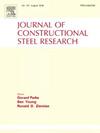Research on shear stress of non-prismatic single-box-multi-cell composite box girders with CSWs
IF 4
2区 工程技术
Q1 CONSTRUCTION & BUILDING TECHNOLOGY
引用次数: 0
Abstract
Limited research has explored the influence mechanisms of internal forces and girder geometric properties on the distribution of shear stress (DSS) within the cross-section of non-prismatic single-box multi-cell composite box girders with corrugated steel webs (SBMC-CBGCSW). Therefore, the purpose of this study is to bridge this gap. According to the equilibrium of infinitesimal elements and reciprocity theorem of shear stress, an analytical formula was first derived for calculating shear stress within the cross-section of non-prismatic SBMC-CBGCSW. Then, the influence mechanisms of internal forces and girder geometric properties on the DSS were investigated. Based on these findings, the shearing bearing ratio (SBR) of the bottom flange (BF) was calculated, and two simplified shear stress calculation methods considering the Resal effect were proposed. Finally, the accuracy of derived formulas was validated against published experimental data and numerical results. Results show that: (1) the shear stress obtained from proposed formulas agreed well with experimental data and numerical results, with discrepancies generally within an acceptable range of approximately 5 %; (2) the DSS is influenced by the interaction of internal forces, the change rate of girder height, and the change rate of BF thickness; (3) the BF may experience the maximum shear stress under the combined action of negative moment, compressive axial force, and downward shear force, where the SBR may reach its peak value. This research advances the understanding of DSS of non-prismatic SBMC-CBGCSW and offers simplified methods for shear stress calculation, providing practical tools to improve the design of the non-prismatic SBMC-CBGCSW.
求助全文
约1分钟内获得全文
求助全文
来源期刊

Journal of Constructional Steel Research
工程技术-工程:土木
CiteScore
7.90
自引率
19.50%
发文量
550
审稿时长
46 days
期刊介绍:
The Journal of Constructional Steel Research provides an international forum for the presentation and discussion of the latest developments in structural steel research and their applications. It is aimed not only at researchers but also at those likely to be most affected by research results, i.e. designers and fabricators. Original papers of a high standard dealing with all aspects of steel research including theoretical and experimental research on elements, assemblages, connection and material properties are considered for publication.
 求助内容:
求助内容: 应助结果提醒方式:
应助结果提醒方式:


